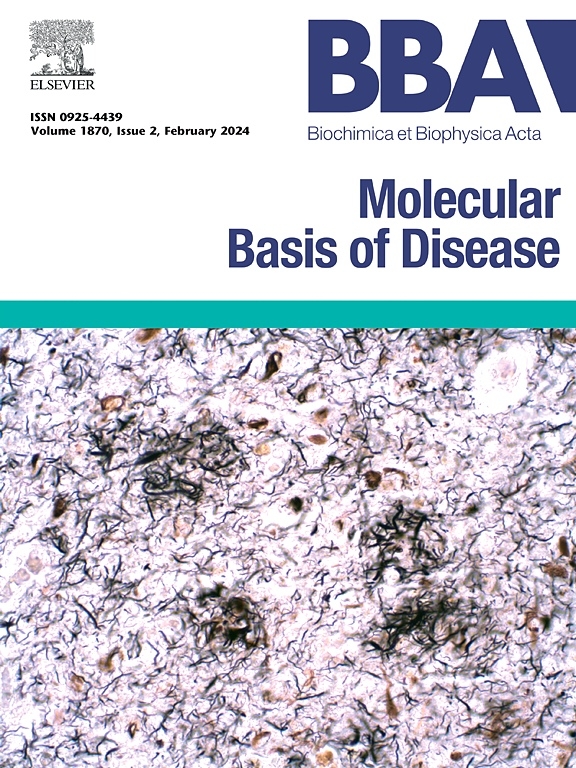在内源性酶缺乏背景下表达人α -半乳糖苷酶A突变体的转基因小鼠:研究法布里病活性位点特异性伴侣治疗的生化动物模型
IF 4.2
2区 生物学
Q2 BIOCHEMISTRY & MOLECULAR BIOLOGY
Biochimica et biophysica acta. Molecular basis of disease
Pub Date : 2004-11-05
DOI:10.1016/j.bbadis.2004.07.001
引用次数: 0
摘要
法布里病是由溶酶体α -半乳糖苷酶A (α -gal A)缺乏引起的先天性鞘糖脂代谢错误。我们建立了在α -gal A敲除背景(TgM/KO小鼠)中专门表达人类α -gal A突变体(R301Q)的转基因小鼠。这可以作为研究和评估Fabry病的活性位点特异性伴侣(ASSC)治疗的生化模型,ASSC针对导致α - gal a错误折叠的错义突变。纯合子TgM/KO小鼠的α - gal a在心脏、肾脏、脾脏和肝脏中的活性分别为52.6、9.9、29.6和44.4单位/mg蛋白,对应于16.4-、0.8-、在具有相似遗传背景的非转基因小鼠的同一组织中,内源性酶活性是前者的0.6倍和1.4倍。1-deoxygalactonojirimycin (DGJ)是α - gala的竞争性抑制剂,也是Fabry病的有效ASSC,在小鼠的饮用水中以0.05 mM的剂量口服2周,心脏、肾脏、脾脏和肝脏的酶活性分别增加13.8倍、3.3倍、3.9倍和2.6倍。DGJ处理后,TgM/KO小鼠的心脏中未检测到globotriaosylceramide (α - gal a的天然底物)的积累,表明该剂量的DGJ未抑制心脏中糖脂的降解。从TgM/KO小鼠(TMK细胞)培养的纯合子和杂合子成纤维细胞中α - gal A的活性分别约为39和20单位/毫克蛋白。这些TgM/KO小鼠和TMK细胞是研究ASSC治疗机制和筛选Fabry病ASSC的有用工具。本文章由计算机程序翻译,如有差异,请以英文原文为准。
Transgenic mouse expressing human mutant α-galactosidase A in an endogenous enzyme deficient background: a biochemical animal model for studying active-site specific chaperone therapy for Fabry disease
Fabry disease is an inborn error of glycosphingolipid metabolism caused by the deficiency of lysosomal α-galactosidase A (α-Gal A). We have established transgenic mice that exclusively express human mutant α-Gal A (R301Q) in an α-Gal A knock-out background (TgM/KO mice). This serves as a biochemical model to study and evaluate active-site specific chaperone (ASSC) therapy for Fabry disease, which is specific for those missense mutations that cause misfolding of α-Gal A. The α-Gal A activities in the heart, kidney, spleen, and liver of homozygous TgM/KO mice were 52.6, 9.9, 29.6 and 44.4 unit/mg protein, respectively, corresponding to 16.4-, 0.8-, 0.6- and 1.4-fold of the endogenous enzyme activities in the same tissues of non-transgenic mice with a similar genetic background. Oral administration of 1-deoxygalactonojirimycin (DGJ), a competitive inhibitor of α-Gal A and an effective ASSC for Fabry disease, at 0.05 mM in the drinking water of the mice for 2 weeks resulted in 13.8-, 3.3-, 3.9-, and 2.6-fold increases in enzyme activities in the heart, kidney, spleen and liver, respectively. No accumulation of globotriaosylceramide, a natural substrate of α-Gal A, could be detected in the heart of TgM/KO mice after DGJ treatment, indicating that degradation of the glycolipid in the heart was not inhibited by DGJ at that dosage. The α-Gal A activity in homozygous or heterozygous fibroblasts established from TgM/KO mice (TMK cells) was approximately 39 and 20 unit/mg protein, respectively. These TgM/KO mice and TMK cells are useful tools for studying the mechanism of ASSC therapy, and for screening ASSCs for Fabry disease.
求助全文
通过发布文献求助,成功后即可免费获取论文全文。
去求助
来源期刊
CiteScore
12.30
自引率
0.00%
发文量
218
审稿时长
32 days
期刊介绍:
BBA Molecular Basis of Disease addresses the biochemistry and molecular genetics of disease processes and models of human disease. This journal covers aspects of aging, cancer, metabolic-, neurological-, and immunological-based disease. Manuscripts focused on using animal models to elucidate biochemical and mechanistic insight in each of these conditions, are particularly encouraged. Manuscripts should emphasize the underlying mechanisms of disease pathways and provide novel contributions to the understanding and/or treatment of these disorders. Highly descriptive and method development submissions may be declined without full review. The submission of uninvited reviews to BBA - Molecular Basis of Disease is strongly discouraged, and any such uninvited review should be accompanied by a coverletter outlining the compelling reasons why the review should be considered.

 求助内容:
求助内容: 应助结果提醒方式:
应助结果提醒方式:


